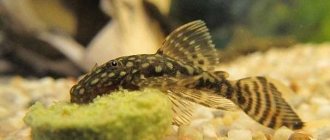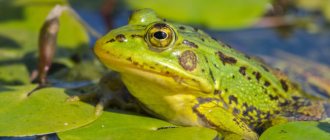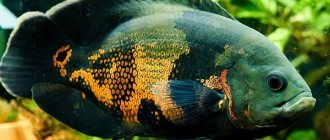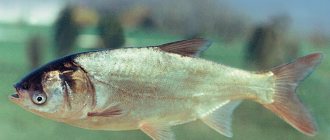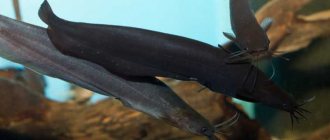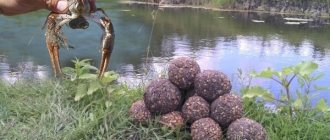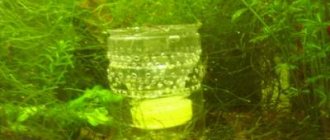Freshwater fish Astronotus (or cichlids) are quite large in size, so their feeding in aquarium conditions should be quite rich and thoughtful. The species diversity available today does not pose any particular difficulties. These fish are not too demanding, and if simple rules are followed, even beginners can successfully keep them, preferring either ready-made or live food. In this article we will look at what is best to feed astronotus.
Description, appearance
Astronotuses belong to the category of fairly large aquarium fish, and in their natural habitat their body length can be 35-40 cm. When kept in aquarium conditions, such an ornamental fish grows to a length of 15-22 cm, has large eyes and head, and is also distinguished by its pronounced and a fairly convex frontal part.
The colors of astronotuses are very diverse. The red decorative variety of astronotus has become widespread. The juveniles vaguely resemble their parents, but have a jet-black color with white streaks and the presence of a small star-shaped pattern throughout the body. Most often, the color of the general background varies from grayish-brown tones to coal-black, with the presence of scattered and large spots, as well as yellow stains of various shapes and sizes, which may have a pronounced black border. The base of the caudal fin is characterized by a large black spot framed by an orange stripe, which resembles the appearance of a large eye. There is an assumption that it was thanks to this very peculiar “eye” that astronotuses were awarded the species name “Ocellatus”, which means “eye-shaped” in Latin.
Return to content
Variations with changes in body shape
Veil Oscar This variation is characterized by elongated fins, but can also have different body colors.
Photo of Veiled Astronotus (ill. small-pets.lovetoknow.com)
Short-bodied Oscar Individuals have a short, compact body. The color of the fish can be any of those presented above. This is a relatively rare breeding form. Much more often on the market you come across simply tight specimens with a deformed body that were kept in poor conditions.
Short-bodied Oscar
Other species In addition to Astronotus ocellatus, there are also two other species - Astronotus orbicularis, Astronotus crassipinnis. The issue of classifying them into one or two species has not yet been resolved.
Types and description
Astronotus is a fairly large representative of cichlids, the size of which reaches 40 cm, in an aquarium it is slightly smaller - 25–30 cm. It has an oval, flattened body and a bright color, which depends on the variety.
At first glance, it may seem that the fish has no teeth. Although in predators such as piranhas, they protrude outward. The fact is that cichlids have so-called pharyngeal teeth, very inconspicuous and small, but sharp. Therefore, the fish can bite very painfully.
There are several types of astronotuses:
Brindle. The progenitor of all species of these tropical fish with a gray or brown body and bright crimson or red spots, sometimes with a black edging. The fish has large fins, and next to the tail there is a noticeable blurry spot that looks like an eye.
Astronotuses can adapt to their environment by changing body color
Albino. From the name it is clear that this is a white fish with orange and scarlet splashes and large red eyes. This species has large and rounded dorsal and anal fins.
Albino astronotus eyes can be pink or red
Veiled. The color of this representative is uneven and may vary. The breed is distinguished by particularly long fins, which create an unusually impressive impression when moving.
Veiled Astronotus is more susceptible to parasitic disease due to the structure of the fins and tail
Red. It is characterized by uniform coloring and absence of stains. Can be bright red and orange. The fins are medium in size with a black border along the edges.
Astronotus red is the most common fish of the species
Gold. This species appeared as a result of selection and differs in appearance from red only in color. The scales of such astronotuses are golden and yellow.
Astronotus gold differs from red only in body color
Selection of neighbors
Before you get astronotus, you need to know who they get along with in the aquarium. These cichlids are quite peaceful species if they live with fish of the same size.
Important! Astronotuses are carnivorous, so they consider any prey that is large enough to fit into their mouth as food.
In a large aquarium with a volume of more than 1000 liters, these cichlids can be kept with other large fish. For example, Boesman's melanotenia, measuring 10 cm or more, may be neighbors. Astronotus also get along well with ancistrus, turquoise acara and large discus.
Mating at home
The difficulty in breeding astronotuses is finding a pair. If this is the case, then breeding cichlids will not be difficult.
The spawning tank must be spacious. It is necessary to place flat stones or objects with a flat surface in it.
An increase in temperature by a couple of degrees stimulates sexual behavior. The male begins to prepare a place for spawning and care for the female. At this time, the male has a small vas deferens, and the female has a clearly visible ovipositor. The color of the fish becomes brighter. The eggs are deposited on rocks or on the bottom of the aquarium. Fish can lay up to 2 thousand eggs at a time, but in captivity there are never more than 400 of them. The eggs are white, cloudy, about 1.5 mm in diameter.
If the goal of breeding is to obtain as many fry as possible, then the eggs must be transferred to the hatchery along with the substrate. Water must be poured into this container from the spawning tank. If this is not done, the caviar will be eaten. And if the eggs remain, then a maximum of 20-30 fry grow to adulthood.
After transferring the eggs to a separate container, it is recommended to install an air sprayer above it to create a weak flow of water. The larvae should appear on day 3-4 if the water temperature is about 30°C. It is necessary to remove the substrate with unfertilized eggs at this moment
It is very important to install a filter to purify water.
After 7 days, the fry spread throughout the aquarium. At the beginning, the food for them is Artemia nauptils, and then they add chopped tubifex and tetramine
After a few weeks they can be given bloodworms. The fry grow quite quickly - at 1 month their size reaches about 3 cm.
These fish spawn 10 times in a row, the interval is about 3 weeks. After this they rest for more than 2 months.
Before breeding astronotus, you need to think carefully - these fish require special and high-quality care.
Choosing a location for an aquarium
Fish require a certain temperature. Therefore, when installing an aquarium in a cold room, you need to take care of the heater - in the cold, astronotuses weaken and this leads to their death. But it is not recommended to place an aquarium near the battery - high temperatures are also dangerous for fish.
When installing a glass container near a window, you need to make sure that there is no direct sunlight, otherwise the water may get too hot. It is better to cover the windows with curtains or protective film. There may be a draft near the windows - fish don’t like this either. Bright light promotes the rapid growth of small algae - they can cover the walls of the aquarium, the bottom and the stones, you will have to clean all of this.
You should not place an aquarium near the entrance doors, because in winter there are many drafts in this place. A children's room is also not considered the most suitable place - while children are small, they can accidentally break an aquarium while playing.
Cats living in the house also pose a danger to fish. Care must be taken that they cannot reach the fish. It is best to cover the aquarium with a lid.
A suitable place for a glass container with fish would be a corner of the room. This is a calm place and the aquarium will decorate your room.
Did you know? Individuals can form families for life, with older children helping to look after the young that have recently hatched.
Ctenopoma kingsleyae
Ctenopoma glaucosa
Comfortable water parameters for keeping: 20-24°C, dH 10-30°, pH 6.8-8. Light aeration, filtration and regular replacement of up to a third of the volume of water in the aquarium are necessary.
Description:
Homeland - western Africa from Senegal to Congo.
Ctenopoma glaucosa in nature reaches up to 20 cm in length, in an aquarium it is less.
The body is elongated, rather high, flattened laterally. The teeth on the posterior edge of the operculum are clearly visible.
When catching a fish with a net, special care must be taken: the fish can get caught on it with its gill teeth
From the editor: Pecilia balloon
The body color is either gray-brown or reddish-brown, the belly is silvery, and there is a black spot on the caudal peduncle.
To keep the fish you need a large aquarium with a volume of at least 200 liters. The aquarium is equipped with shelters: driftwood, grottoes and thickets of aquarium plants.
The fish are fed with live food, vegetable food and substitutes. Likes live food, including small fish.
Care and cleaning
You need to install a fairly powerful filter in the aquarium, since astronotus prefer food containing protein, and each feeding ends with water contamination. Therefore, it is important to install a filter that will help clean the aquarium from various harmful compounds.
It is better to use external canister filters, which provide good water purification.
Aeration can also be used to maintain oxygen in the water. to change at least 30% of the water weekly in order to remove nitrates from the water resulting from biofiltration.
Chocolate Ctenopoma (Ctenopoma oxyrhynchus)
Comfortable water parameters for keeping: 22-28°C, dH 4-15°, pH 6–7.5. Light aeration, filtration and regular replacement of up to a third of the volume of water in the aquarium are necessary.
Description:
Homeland - Central and Western Africa.
Ctenopoma chocolate reaches up to 10 cm in length.
The body is elongated, rather high, flattened laterally. The main color is red-brown, with a dark marbled pattern. Fish breathe atmospheric air using the gill labyrinth.
To keep the fish you need an aquarium with a volume of at least 80 liters. The aquarium is equipped with shelters: driftwood, grottoes and thickets of aquarium plants.
The fish are fed with live food, vegetable food and substitutes.
All of the above is just the fruit of observing this type of aquarium fish and collecting various information from owners and breeders. We would like to share with visitors not only information, but also live emotions that allow us to understand the world of aquariums more fully and subtly. Register at https://fanfishka.ru/forum/, participate in discussions on the forum, create profile topics where you will talk about your pets in the first person and from the horse’s mouth, describe their habits, behavior and content, and share with us your successes and joys, share your experiences and learn from the experiences of others. We are interested in every bit of your experience, every second of your joy, every awareness of a mistake, which makes it possible for your comrades to avoid the same mistake. The more of us there are, the more pure and transparent drops of goodness there are in the life and everyday life of our seven billion society.
How much are?
The cost of one individual will depend not only on the place of purchase (network, private store or second hand), but also on the size of the astronotus. So, juveniles up to 5 cm on average cost 250-500 rubles each, a “teenager” of 15 cm costs more than 1000 rubles, an adult fish costs around 5000 rubles.
It would take a long time to describe the features of keeping astronotuses, but the most valuable thing is the personal experience of aquarists. Share stories about your underwater pets in the comments and the difficulties you encountered.
If you are just planning to have this representative of cichlids, ask questions.
Description and characteristics of the fish, as well as conditions for keeping astronotus at home
An adult astronotus can reach a length of 35 centimeters.
The body of the fish is elongated and flat on the sides. Large head with a massive forehead. The eyes are huge. The fins are large. The color of the fish is completely varied. The most common:
- natural color;
- copper color;
- albino.
Interestingly, during stress, fish can change their color.
Necessary conditions for maintaining an astronotus:
- constant saturation of water with oxygen;
- powerful water filters;
- regular partial water changes (about thirty percent of the total volume);
Water filtration is especially important; if one filter is not enough, then you need to install a second one. The aquarium can be decorated with decorative stones and various decor, but there is one condition. The decor should be smooth, without sharp protrusions that could injure the fish.
It should be taken into account that, due to their activity and aggressiveness, astronotuses constantly dig the soil in the aquarium, dig up and pull out plants. Therefore, the decor must be securely fixed and it is recommended not to use soil, but to decorate the bottom of the aquarium with stones, castles, shells and driftwood. If, however, it is decided to use soil, then it should be the finest and its layer should be no more than two centimeters.
Astronotus feeds on bloodworms, worms, sea fish, and specialized dry food. Dry food today is presented on the market in a wide range.
This fish is an incredible glutton and, in order to prevent diseases of the gastrointestinal tract, you should feed the fish only once a day. Also, one fasting day a week will be useful.
You can supplement the diet with live fish, squid, frogs and shrimp, as well as oatmeal and plant foods, such as lettuce.
It is very important to know when to stop and diversify your diet. Monotonous feeding will harm the fish
There is no need to feed only live fish, as the astronotus may become addicted to it and refuse other food.
The diet of the astronotus should be varied and balanced. This is the most important condition for successfully keeping aquarium fish at home. And this is true not only for cichlids, but also for any aquarium fish.
It is still worth taking into account the food preferences of a particular fish. Since they eat according to their needs, Astronotus may need plant foods and eat only that, or may prefer protein food.
A popular option for feeding astronotus is dry specialized food. It contains all the necessary nutrients for the proper development of the fish.
The owner of the aquarium must carefully read the label when purchasing food. The date of manufacture in this case is very important. Therefore, it is not recommended to purchase loose feed. Dry flakes or granules should be stored in tightly closed containers or bags.
Blanks for future use
If your fry are growing up, then you need to take care of their diet in advance. In spring and summer it is very good to harvest grasshoppers and similar insects. If possible, start breeding snails. You can catch them in the garden using bait. This is an excellent feeding for growing predators.
If you prefer ready-made, granulated food, then you need to give preference to high-quality types with a high content of astaxanthin. These include Tetra Ruby, Tetra Discus, and Hikari. Additionally, you can diversify your diet with vegetable components. Some cichlids eat cabbage, green peas, tomatoes, cucumbers, and zucchini with great pleasure. It is best to teach them to this from an early age, so that later they do not have problems with digestion. If fish get vegetables, they usually leave the plants alone.
Features of keeping Astronotus fish
When keeping astronotus in an aquarium, certain conditions must be observed. The first requirement will be the size of their house - based on the size of the fish themselves, it is necessary to provide a pair of astronotuses with living space with a capacity of at least 250-400 liters.
In the photo there is an albino astronotus
These fish are not particularly picky about water; the temperature can be 20-30 C⁰, acidity 6-8 pH, hardness about 23⁰. Again, looking at the size of these fish, you need to understand that they need to change the water frequently - up to 30% of the volume should be changed weekly.
In addition, it is necessary to install a good high-performance filter so that fish waste products do not poison the water. In addition, astronotuses love to make a mess in the aquarium - dragging pebbles, pulling out grass, displacing various artificial decorations and equipment.
Therefore, it is better to discard small parts, otherwise you will have to constantly collect them around the aquarium and put them in place. Instead of soil, you can put several large smooth boulders on the bottom, place algae that are not growing, but floating, and fix the equipment well. It is worth avoiding sharp and cutting decorations, as the fish can easily get injured if they start another rearrangement.
In the photo Astronotus tiger
Another requirement for an aquarium is that it must be equipped with a lid. Since astronotuses accelerate quite quickly in the water, and in pursuit of something or someone they may well jump out and end up on the floor.
One of the most interesting and pleasant features for the owner of an astronotus fish is that this fish can remember its owner, swims up to your hands and even lets itself be stroked with pleasure.
From the editor: Moss, cotton wool, fluff on the body of fish is a treatment?
If a person is near the aquarium, then this fish, unlike others, can follow the actions of its owner, as if interested in his affairs. This intelligent behavior is very captivating to aquarium enthusiasts. However, you need to hand feed carefully, as the fish can bite.
Diseases
Astronotus diseases can be divided into 2 types: non-contagious and contagious. We present all of them in the picture.
A popular disease is hexamitosis: ulcers appear on the body, often on the head, and mucus appears on the astronotus in these places. This is most often caused by a lack of vitamin C due to improper feeding (for example, feeding only beef or pork) or the use of activated carbon for the filter. It is treated with diet and by adding metronidazole or other medications to the food.
A common problem is that the astronotus lies on the bottom (or they pant heavily to the bottom and lie on their side), breathes heavily and has a swollen or swollen belly. Usually the stomach is bloated due to poor nutrition (for example, you fed them minced meat, and this can create bloating), and therefore intestinal obstruction, or illness can be caused by low temperature. Raise the temperature in the aquarium environment and add table salt to the water (1 tablespoon per 20 liters) so that the fish’s swollen tummy goes away.
In order to fight off diseases in advance, new individuals must be kept in an isolation ward for 5 days. Plants and new decorative elements must be pre-treated (placed in a pale pink solution of potassium permanganate or boiled) to prevent the contents of the aquarium from becoming infected with the disease. It is better not to spoil cichlids with river fish, since they are often the source or carrier of the disease.
Feeding
Astronotuses in the aquarium are omnivores. Their diet is varied and includes:
- aquatic and terrestrial vegetation;
- plankton;
- insects;
- crustaceans;
- frogs.
Often these large fish can eat a small rodent. The main part of the daily menu is animal food, vegetation makes up only 1/3.
Feeding the astronotus will not cause problems, since it does not disdain either artificial or frozen food, happily consuming special granules for cichlids. Small worms and bloodworms are suitable for fry. Mature fish can already be given earthworms, locusts, crickets and other insects, sea fish fillets, as well as shrimp, squid and mussels.
A good option for plant food would be peas, finely chopped lettuce, spinach, pieces of zucchini and Chinese cabbage, which will provide the fish with the necessary level of vitamin C. Occasionally, you can give bread soaked in water and rolled oats.
Finely chopped pieces of boiled beef heart and boiled chicken can be offered to these meat lovers. However, the percentage of such protein in the total amount of food should be low: the fats contained in meat over time cause deformation of the internal organs of the fish and clog blood vessels. Most of all, astronotus like to eat guppy fish, platies and swordtails. Often these types of fish are bred specifically to feed the South American cichlid.
Since astronotus aquarium fish are voracious, they should be fed no more than 2 times a day. All types of food should be alternated, and once a week it is imperative to arrange a fasting day.
Video: feeding astronotus
Only astronotus purchased in specialized stores should be placed in your aquarium. If the fish has an unknown place of origin, there is a high probability of infecting the entire aquarium with serious diseases.
What should you give up?
When purchasing fry from unscrupulous breeders, you may receive a recommendation to feed them mammalian meat. But today it has been proven that this particular type of food is contraindicated for them. It is poorly digested, which leads to the development of pathological processes in the fish’s body. The only exception is beef heart. And even then it should be given no more than once a week.
The specific nutrition of fish still leads to the fact that the level of ammonia in the aquarium is constantly growing. This will lead to poisoning of pets. Cichlids are very sensitive, so it is recommended to change the water once a week and add at least 1/5 of the total volume of the aqua.
General description of astronotus
When kept in an aquarium, Astronotus can grow to approximately 30 centimeters in length. Growth stops after 3–4 years. The color can be varied, it all depends on the type of fish, and breeders are constantly producing something new.
Fish of this species are distinguished by their beauty, originality, and interesting coloring. Perhaps it’s worth starting with the fact that aquarists who decide to acquire an astronotus will have to come to terms with the fact that there will be no other beautiful, unique and interesting fish in their aquarium.
After the astronotus grow and are 10–12 centimeters long, they will simply disfigure or eat other inhabitants of the aquarium, for example, gouramis, macropods, goldfish and other beautiful representatives of aquariums do not get along with this fish. The same action will be expected for ampullaria snails.
What is the lifespan of astronotus in an aquarium? The answer to this question depends entirely on the conditions in which they will be kept. But, in fact, they are famous for their longevity. They live from approximately 10 to 18 years.
The colors of these fish are very diverse. But basically they are divided into the following types:
- Blue;
- Red;
- Nut;
- Brindle;
- Albino.
In general, one can only envy the variety of colors of astronotuses, photos of which will be given below!
Astronotuses
Compatibility
Astronotus have good compatibility. But don’t forget, this is first and foremost a predator; if it meets any of the aquarium fish that is smaller than it, it will swallow it. Keeping with other fish is successful if they themselves are large.
But compatibility with other fish is quite conditional, even with them he can get into fights, more often this happens during maturation or during spawning, so be prepared for this.
It is advisable to place large males among themselves. They will only get along well in a very large aquarium.
As you can see, the key factor: only fish that are not inferior in size get along with the astronotus.
Breeding, propagation of astronotuses
How to distinguish a male from a female astronotus? Sexual dimorphism is poorly developed. It is possible to accurately determine the sex of an adult astronotus only by the primary sexual characteristics that appear during spawning.
Below are some signs by which you can try to distinguish an adult male from a female Astronotus:
1. Female astronotus are characterized by a more rounded belly.
2. The distance between the eyes of males is usually greater than that of females.
3. The back of the female in the area of the anal fin is pear-shaped, while in males it is most often smooth, without noticeable bulges.
4. There is an opinion that males are larger than females, but this point can only be used if your fish lived in the same aquarium. And choosing a female or male in a store, especially if they are different in age, is almost impossible.
5. The pelvic fins of males are slightly longer and more pointed at the ends than those of females.
6. The frontal part of the male’s body may be more convex than that of the female.
The listed characteristics are relative and can only be used as a hypothesis about the field of a particular astronotus.
The main problem in breeding astronotuses is pair formation. To do this, breeders usually take a flock of Astronotus fry, up to 15 tails, place them in an aquarium of at least 300 liters and feed them abundantly throughout the year (until puberty). When this happens, the fish split into pairs and occupy a separate territory in the aquarium. The territory begins to be guarded, all border violators receive cuffs. From this point on, the fish are transferred to moderate feeding.
Next, the selected, formed pair is placed separately in a spawning aquarium and spawning is stimulated by raising the temperature to 30 degrees and changing the water.
A couple of hours before spawning, the female has an ovipositor, and the male has a spermatic duct. At this time the pair is brightly colored.
Having thoroughly cleaned the bottom of the aquarium or the stone, a couple of producers lay from 500 to 1500 large eggs, beige in color.
Next, the eggs are either left with the producers or transferred to a hatchery, the volume of which should be about 20 liters. If the eggs are transferred, the aquarist takes full care of them. In the sedimentation tank, weak aeration is installed above the masonry, and a fungicidal septic tank is added to the water - methylene blue (to a faint blue color).
The incubation period of eggs is approximately 50 hours, after which the larvae begin to hatch. On the fourth day, the larvae begin to swim. From this time on, they begin to be fed, first with live dust, then gradually with larger feeds.
Editorial: Hemianthus micranthemoides
The fry grow quickly and reach 2.5-3 centimeters by the age of one month. Astronotus spawn up to 10 times, with an interval of 3-4 weeks, followed by a break of 2-3 months. The fish is capable of producing offspring up to 12 years of age.
Description and characteristics
The aquarium fish Astronotus belongs to the cichlid family, and in the wild it reaches impressive sizes - some individuals grow up to 40 cm in length. Initially, the ocellated astronotus, so named for the small rounded spot near the caudal fin, was a wild fish, but aquarists loved it so much that they decided to turn the phenotype into a pet. Under natural conditions, fish live in water bodies of South America, Australia and China. In its homeland, the phenotype is considered commercial because it has tasty meat.
The appearance of Astronotus is remarkable: the phenotypes are brightly colored, the colors of individual specimens differ from each other. The main tone of the scales is gray or black, and there are orange stripes or spots throughout the body, which is why the species is nicknamed leopard or tiger astronotus. Females are more modestly colored than males, whose scales are more saturated in color. During spawning or mating games, the color of the fish acquires a black tint, and the spots become fiery scarlet. The same changes in appearance occur when astronotus fish fight for territory, become stressed or anxious, or simply fight.
The color of the scales indicates not only the emotional state of the phenotypes, but also the age of the pets. Young representatives are not as intensely colored as adult fish, and the inclusions on the body are light or creamy.
Before buying pets, you should know how long astronotuses live, as well as the peculiarities of keeping them at home. With good care and compliance with the rules, astronotus aquarium fish live for 20 years, which is an undeniable advantage of the species.
Varieties
Thanks to the tireless work of breeders, in addition to the wild species, hybrid popular varieties of fish were bred, which differ in color and shape. Types of Astronotus in aquarium keeping:
- Tiger - the color of the scales is gray-green, there are orange-scarlet inclusions on the body, due to which the color of the fish resembles the skin of a tiger. A distinctive feature is a rounded spot near the caudal fin.
- Red Oscar astronotus - dark body tone, with an orange coating. The characteristic spot near the tail is missing. The Red Astronotus was artificially bred to increase the scarlet color in its color.
- Albino is a fish with a snow-white body color, on which fiery, orange or pink stains are located in a chaotic manner. Albinos have a red pupil, and the phenotype itself is extremely sensitive to bright light.
- Albino brindle - distinguished by a cream-colored body with red or orange patterns.
- The Sunny Lemon is a cute, light-colored fish that may have blotches, spots or stripes of yellow on its body.
- Golden - a phenotype with yellow or golden flecks on a dark or cream background.
- Bloody - red astronotus, characterized by an extremely rich color of the body and fins.
- Veil - a fish with long, lush fins of any color.
- Balloon is a variety that is small in size and has a short body due to a mutation that has a growth-limiting phenotype.
Content Features
Since astronotuses are large in size, they require a spacious container of approximately 400 liters. This is also due to the rapid growth of fish. It is quite difficult to maintain cleanliness in a tank with this type, so it is better to immediately buy an external biofilter that can effectively purify water from ammonia and other substances.
Astronotuses require a spacious aquarium of 400 liters or more.
It is necessary to pay attention to a sufficient amount of oxygen in the aquarium if Astronotus tiger lives in it. Maintenance requires good aeration and water filtration
To maintain the health of the inhabitants, it is enough to change the water by 1/3 weekly and monitor its temperature. Water at a level of 23−27 C is considered optimal.
Despite the simple content, in the container where the Astronotus cichlid lives, it is advisable to place gravel, pebbles or coarse river sand on the bottom. Perfect for decoration:
- stones;
- driftwood;
- other heavy objects.
The decor in the aquarium should be close to natural conditions. Among plants, it is advisable to give preference to hard-leaved species with a powerful root system, growing in separate containers. Artificial plantings are suitable as an alternative.
Dim lighting will help the fish feel more protected. They tolerate slightly acidic and alkaline environments well with an optimal pH level of 6−7.5 units. and hardness from 6 to 20 d GH.
https://youtube.com/watch?v=M30udsQ_LFo
Cichlid nutrition
These fish are considered omnivores, but the basis of their diet is food of animal origin. Plant foods are needed as an additional source of essential substances.
The best food for cichlids is pellets. They must contain live mosquitoes and frost. If you buy them dry, then you need to choose large ones, since small ones will not be eaten completely, but will only contaminate the water in the container.
The very popular bloodworm should only be given to young animals. It is better to feed adult fish with larger live food:
- earthworms;
- insects (crickets, grasshoppers).
Ostronotuses feed on everything, but the basis of their diet is animal food.
Before giving earthworms, they must be kept in water for 3-4 days so that they are cleared of the remaining soil. Aquarists also often include squid, shrimp, sea fish, pieces of beef, liver and heart in the diet of astronotus. They freeze the minced meat from these products and then use it as feed.
Some aquarium fish lovers believe that mammalian meat is harmful to the health of their pets. To eat astronotus, they buy guppies, swordtails and goldfish fry, specially bred for this purpose. Fish caught in natural sources may contain infection, which poses a health hazard to cichlids.
Compatibility with other inhabitants
It is believed that Astronotus is a fairly peaceful fish and can get along with other representatives in the same aquarium if it is spacious. However, carnivory is a concern, so it is not recommended to keep them with small species that could be perceived as food.
Larger representatives will not allow themselves to be offended, which can cause conflicts, to avoid which a large-sized aquarium is necessary. Astronotuses often disturb the peace of other inhabitants by starting to dig the soil or play with equipment or decorative items. For this reason, it is best to place them as a pair in a separate container.
You should not choose small fish as aquarium neighbors for astronotus.
Reproduction and offspring
Female astronotus are very difficult to distinguish from males. This is clearly noticeable only during the spawning period, when egg laying appears. They are also distinguished by a more rounded belly shape. Most often, breeders buy 1 dozen young animals, after which, when the astronotus reaches sexual maturity, pairs are formed. This happens when the fish grow to 10-12 cm.
You can breed them in the aquarium where they live. To do this, create shelters with large flat stones, among which the fish will lay eggs, having previously cleared their favorite place.
https://youtube.com/watch?v=C_yb7XEanMc
With proper maintenance and careful care, astronotuses become attached to their owners and delight with unusual behavior. A good diet with a sufficient source of protein, clean and warm water with secluded areas will give this smart and beautiful fish excellent health, and all family members a great mood.
Who do astronotuses get along with?
It is best for these fish to live separately only with their relatives. Moreover, the aquarium should have a volume of 400-500 liters, this will eliminate the fights that astronotuses start during spawning. In a spacious container, the inhabitants feel more relaxed; it is important for them to swim freely.
Experienced aquarists prefer to install 2 tanks at once - one for astronotuses, the other for other fish. If this is not possible, then the following candidates can be considered as neighbors (provided that the aquarium has a volume of at least 1000 liters):
- Geophagus - non-conflict, calm fish from the cichlid family;
- characin metinnis - unpretentious and peaceful aquarium inhabitants;
- ancistrus (catfish) - small catfish that hardworkingly and painstakingly clean up the “mess” that sloppy cichlids make and eat the remains of food falling to the bottom.
When choosing companions for astronotuses, you should listen to the recommendations of experienced aquarium specialists:
- astronotus and small fish are not the best combination; larger cichlids will consider them as food;
- It is desirable that astronotuses end up in an established aquarium with other inhabitants, otherwise they can behave “like sole owners”, aggressively chasing away the “new settlers”;
- it is important to provide the aquarium with vegetation, driftwood, and stones - this will enable bottom dwellers to hide from overly territorial neighbors and lay eggs;
- It is advisable to keep fish of approximately the same size in one tank - they have a better chance of getting along in the same area.
If possible, it is recommended to house these gorgeous cichlids separately. They will be quite enough to decorate the tank.
